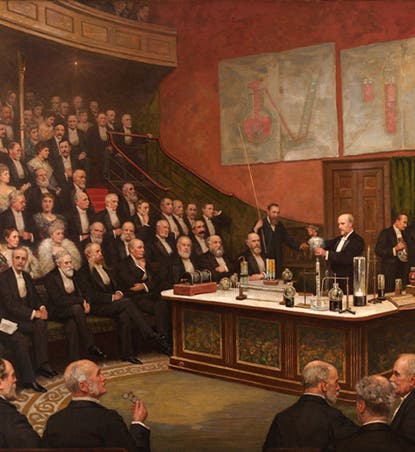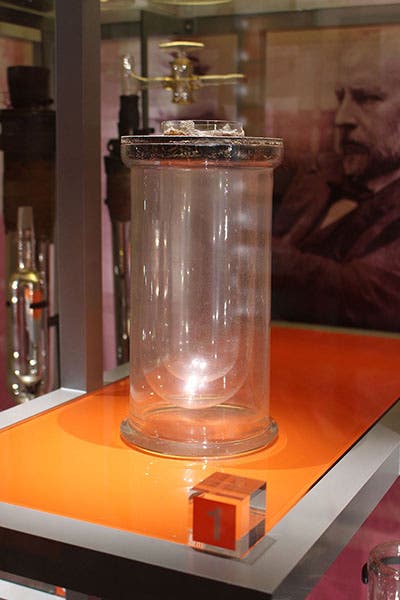Scientist of the Day - James Dewar
James Dewar, a Scottish physicist and chemist, was born Sep. 20, 1842. Dewar was a professor of experimental science at Cambridge and professor of chemistry at the Royal Institution in London, and he held both positions simultaneously for over 45 years until his death in 1923. He investigated all sorts of physical phenomena: spectroscopy, determination of molecular weights, the nature of thin films and bubbles. He was also apparently a gifted demonstrator; our first image shows him giving a Friday Night Lecture at the Royal Institution in 1904.
Dewar’s real love was low-temperature physics. In particular, he wanted to study the properties of gases in their liquid and solid states. When he began at the Royal Institution in 1877, there were six basic gases that had never been reduced to liquid form: nitrogen, oxygen, hydrogen, methane, carbon monoxide, and nitric oxide. Dewar was too late to the chase to be the first to liquefy nitrogen and oxygen, but he was the first to produce liquid hydrogen, which boils at 20 K (20 degrees above absolute zero). With his liquid hydrogen as a super coolant, he could now liquify any gas in the world. And when he managed to lower the temperature another six degrees, he created solid hydrogen.
Dewar was so successful because he was an experimental wizard. He claimed that his manual dexterity came from the aftermath of a childhood illness, when he spent two years learning to make violins. He made or designed all the equipment used at the Royal Institution for super-cooling materials. His greatest contribution to low-temperature physics came in 1892, when he invented the vacuum flask, which in its original form consisted of two glass vessels, one inside the other and separated by a near-perfect vacuum (third image). Liquid gases could now be stored for much greater lengths of time, and Dewar eventually discovered that if you put carbon granules in the vacuum (which absorb the remaining bits of air), not only could you improve the insulating properties, but you could substitute metal for glass, which makes for a much sturdier container (without the carbon, metal vacuum flasks leach gases and corrupt the vacuum). Both versions in their laboratory form came to be called Dewar flasks. Dewar never patented his flask, so the Thermos Corporation stepped in and did so, and if they hadn’t, all those Thermos bottles marketed in the next century would have been called Dewar bottles.
The discovery of helium (on earth) in 1895 gave Dewar another challenge, since helium apparently liquefies at a lower temperature than hydrogen, close to absolute zero, but Dewar lost this race, and probably his Nobel prize, to a Dutch investigator, Heike Kamerlingh Onnes, who accomplished the feat in 1908. Since his birthday happens to be one day later than Dewar’s, we will continue this story tomorrow.
Dr. William B. Ashworth, Jr., Consultant for the History of Science, Linda Hall Library and Associate Professor, Department of History, University of Missouri-Kansas City. Comments or corrections are welcome; please direct to ashworthw@umkc.edu.







